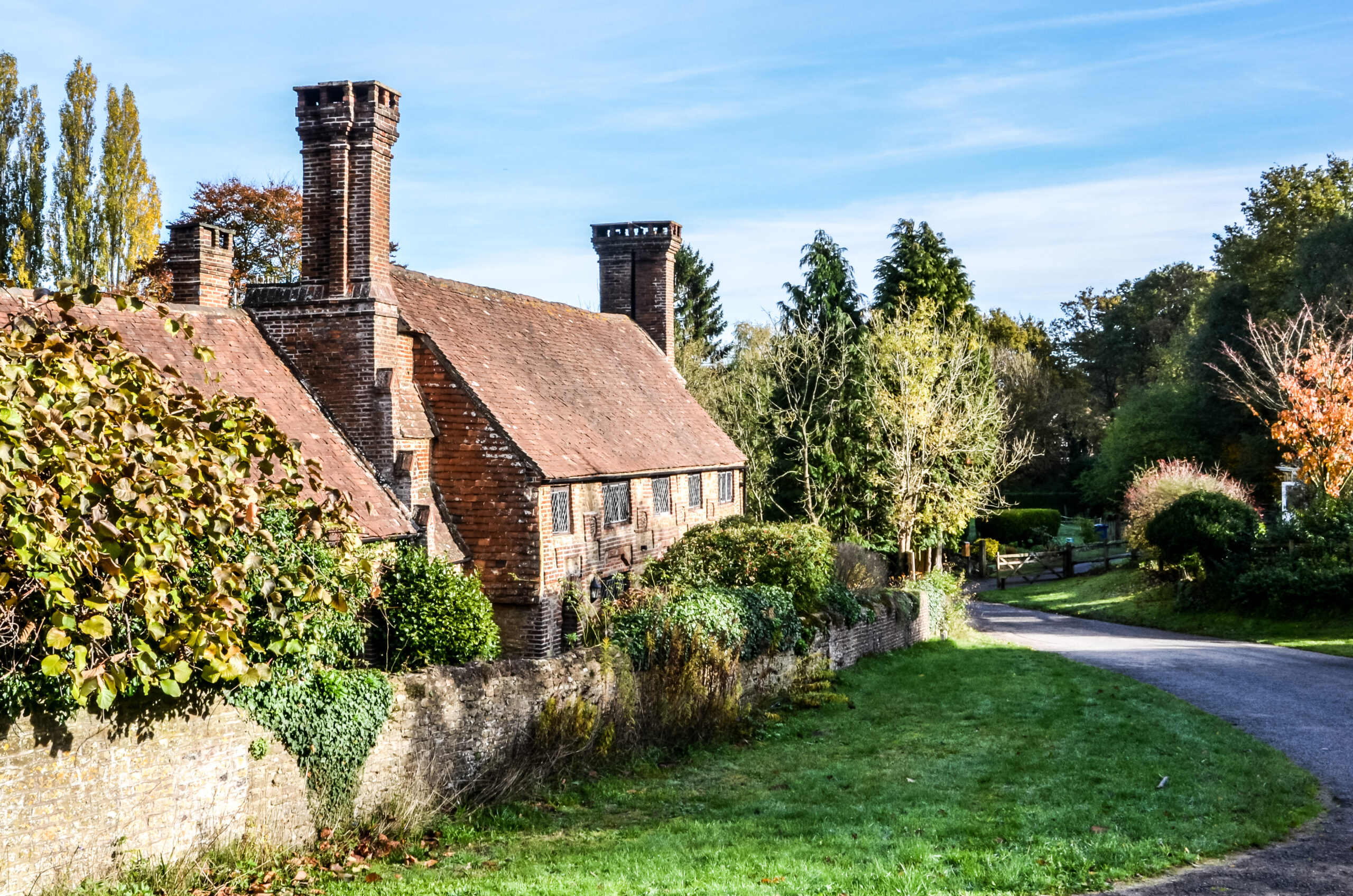Surrey, tucked just south of London, is often seen as a commuter county, yet it holds some of England’s most beautiful countryside, historic estates, and picturesque towns. Defined by the rolling landscapes of the Surrey Hills Area of Outstanding Natural Beauty, its chalk downs, wooded hills, and river valleys form an idyllic contrast to the nearby capital. From the open heights of Box Hill to the meandering River Wey, Surrey is a place where natural beauty is never far away.
Its proximity to London has shaped its identity. For centuries, Surrey attracted royalty, aristocrats, and industrialists who built lavish estates here, many of which survive as visitor attractions. Hampton Court Palace, with its Tudor grandeur and baroque gardens, remains one of England’s most iconic landmarks. Other houses and gardens, like Polesden Lacey, Loseley Park, and Painshill Park, show the county’s role as a canvas for architectural ambition and artistic landscape design.
Yet Surrey is not defined only by grandeur. Its towns and villages—such as Guildford, Farnham, and Dorking—retain their market-town charm, filled with historic churches, coaching inns, and cobbled streets. Local traditions thrive in food, brewing, and crafts, while cultural life flourishes through theatres, galleries, and music festivals.
Surrey’s heritage also includes moments of national significance: it was here that Magna Carta was sealed at Runnymede, where Brooklands pioneered British motorsport and aviation, and where literary figures such as Jane Austen, Lewis Carroll, and Alfred Lord Tennyson found inspiration in its landscapes.
To explore Surrey is to experience a county of dual identities: deeply rural yet connected to London, traditional yet innovative, modest in scale yet vast in cultural impact. Its green hills, historic sites, and enduring spirit make it not merely a neighbour to the capital, but a destination of quiet distinction in its own right.
Guildford
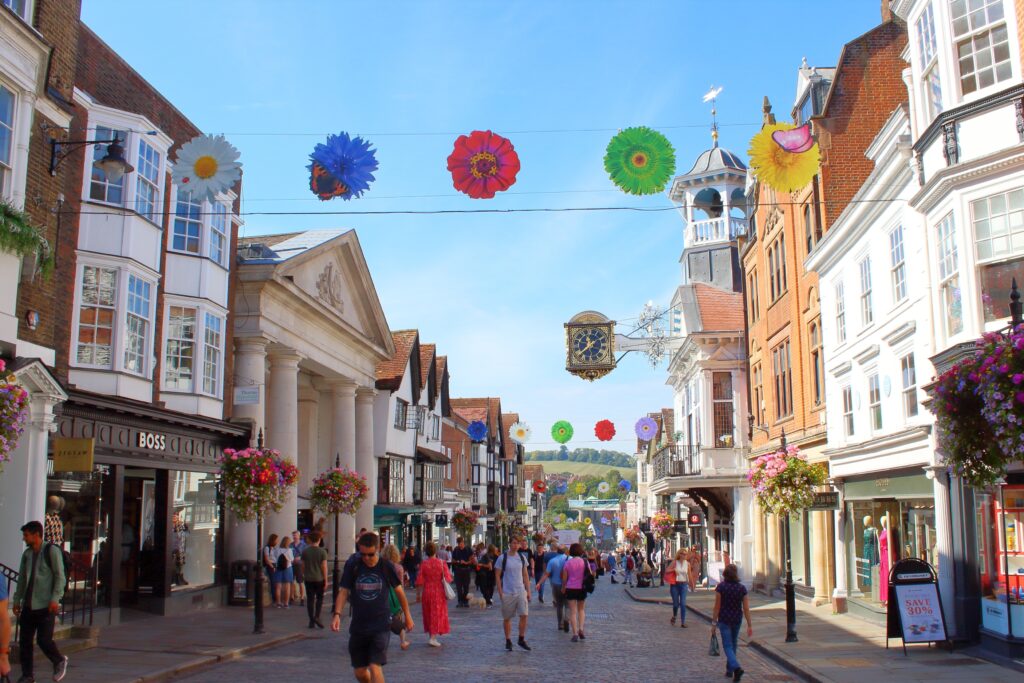
As Surrey’s county town, Guildford is the natural starting point for exploring the county. Straddling the River Wey, it combines medieval heritage with a vibrant modern atmosphere. Its cobbled High Street, lined with historic buildings and the iconic 17th-century Guildhall clock, captures centuries of commerce and community.
At the heart of Guildford stands Guildford Castle, a Norman stronghold whose keep offers panoramic views across the town and surrounding countryside. The castle grounds are beautifully landscaped, with vibrant gardens that provide a peaceful contrast to the town centre. Nearby, the impressive Holy Trinity Church and Guildford Cathedral, with its striking modernist design, reflect the town’s religious and cultural heritage across different eras.
Guildford is also a centre of learning and creativity. The University of Surrey and the Yvonne Arnaud Theatre contribute to a thriving cultural life, while museums such as the Guildford Museum and the Spike Heritage Centre explore its rich history. Literary connections abound too—Lewis Carroll spent much of his later life here, and the town is dotted with references to Alice in Wonderland.
Beyond history and culture, Guildford is a gateway to Surrey’s countryside. The River Wey Navigations provide tranquil walks and boat trips, linking town to nature, while the surrounding Surrey Hills begin almost at its doorstep. This blend of heritage, culture, and landscape gives Guildford a character that is both historic and contemporary, making it a perfect introduction to Surrey.
Farnham
Farnham, lying in Surrey’s western reaches, is one of the county’s most historic and attractive market towns. Its streets are lined with Georgian houses, medieval passages, and coaching inns that tell of centuries of trade and travel. The town has always thrived as a hub for crafts, agriculture, and culture, and today it retains an atmosphere that blends heritage with creativity.

Dominating the skyline is Farnham Castle, first built in the 12th century as a residence for the Bishops of Winchester. Its Norman keep offers sweeping views over the town and surrounding countryside, while the later buildings showcase Tudor, Georgian, and Victorian additions. The castle’s presence has long shaped Farnham’s fortunes, both politically and socially.
At the centre of the town lies the Parish Church of St Andrew, a fine medieval structure that has been a focal point of local life for centuries. Around it, the Maltings, a converted collection of historic buildings, now serves as one of Surrey’s premier arts and community centres, hosting concerts, exhibitions, and festivals throughout the year.
Farnham is also surrounded by natural beauty. To the north lies Farnham Park, a vast medieval deer park with avenues of trees and open meadows. To the south, the heathlands of Frensham Common and Ponds provide a rare landscape of sandy hills, pine woods, and tranquil lakes—perfect for walking, swimming, or simply enjoying the outdoors.
With its rich heritage, artistic energy, and access to some of Surrey’s most striking landscapes, Farnham stands as both a historic gem and a vibrant cultural hub. It embodies the county’s dual appeal: deeply rooted in tradition yet alive with contemporary spirit.
Dorking
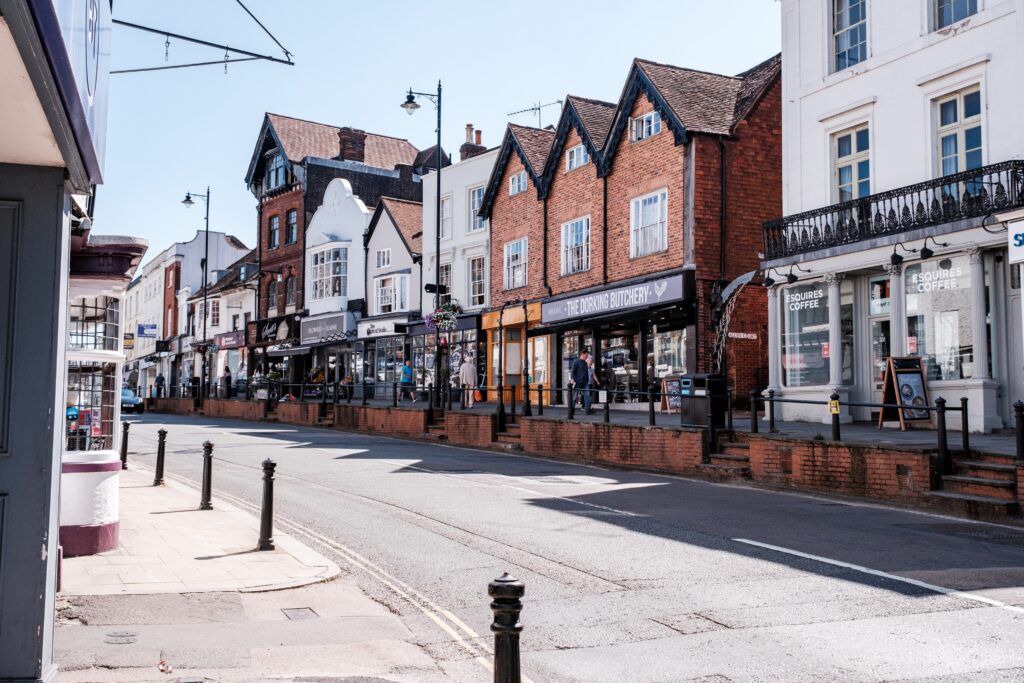
Nestled at the foot of the North Downs, Dorking is a market town whose charm lies in its combination of natural beauty, historic streets, and a thriving food and wine culture. Its location, surrounded by rolling countryside, makes it a gateway to the Surrey Hills Area of Outstanding Natural Beauty, with iconic landmarks such as Box Hill and Leith Hill just a short distance away.
The town itself has a character shaped by centuries of trade. Its narrow lanes—such as West Street, famed for its antique shops—retain an old-world atmosphere. The market tradition continues in regular farmers’ and craft markets, while independent shops, boutiques, and cafés give the town a vibrant local identity.
Dorking has long been known for its culinary connections. The surrounding hills are home to award-winning vineyards, such as Denbies Wine Estate, one of England’s largest and most celebrated. Here, visitors can explore vineyards that stretch across the chalk slopes, tour the cellars, and sample wines that showcase Surrey’s growing reputation in viticulture.
Cultural life in Dorking is equally rich. The Dorking Halls, a 1930s theatre and concert venue, hosts everything from classical music to contemporary performances. Historic churches and houses, such as St Martin’s Church with its striking spire, reflect the town’s deep roots.
Perhaps most compelling is Dorking’s proximity to nature. A short climb to Box Hill reveals one of England’s most iconic viewpoints, celebrated for its sweeping views of the Weald. Meanwhile, Leith Hill, crowned by an 18th-century tower, is the highest point in Southeast England. Together, these landscapes make Dorking a place where town and countryside are beautifully intertwined.
With its blend of heritage, culture, and natural splendour, Dorking stands as one of Surrey’s most rewarding destinations.
Reigate

Set against the backdrop of the North Downs, Reigate is a historic market town that balances medieval charm with a lively modern spirit. At its heart stands Reigate Castle Grounds, a public garden laid out on the site of a Norman castle. Though little of the castle remains, the grounds and their atmospheric caves beneath the town remind visitors of Reigate’s medieval importance.
The town’s High Street mixes historic architecture with independent shops, cafés, and restaurants, while the nearby Priory Park offers sweeping lawns, a boating lake, and woodlands that are perfect for leisurely strolls. The jewel of the park is Reigate Priory, a former monastery turned stately home, now housing a school but still commanding attention with its elegant façade.
Surrounded by the chalk ridges of the Downs, Reigate is also a centre for walking and cycling. The nearby Reigate Hill and Gatton Park form part of the North Downs Way, offering stunning views over the Weald. This balance of heritage, town life, and natural beauty makes Reigate a particularly appealing Surrey destination.
Woking
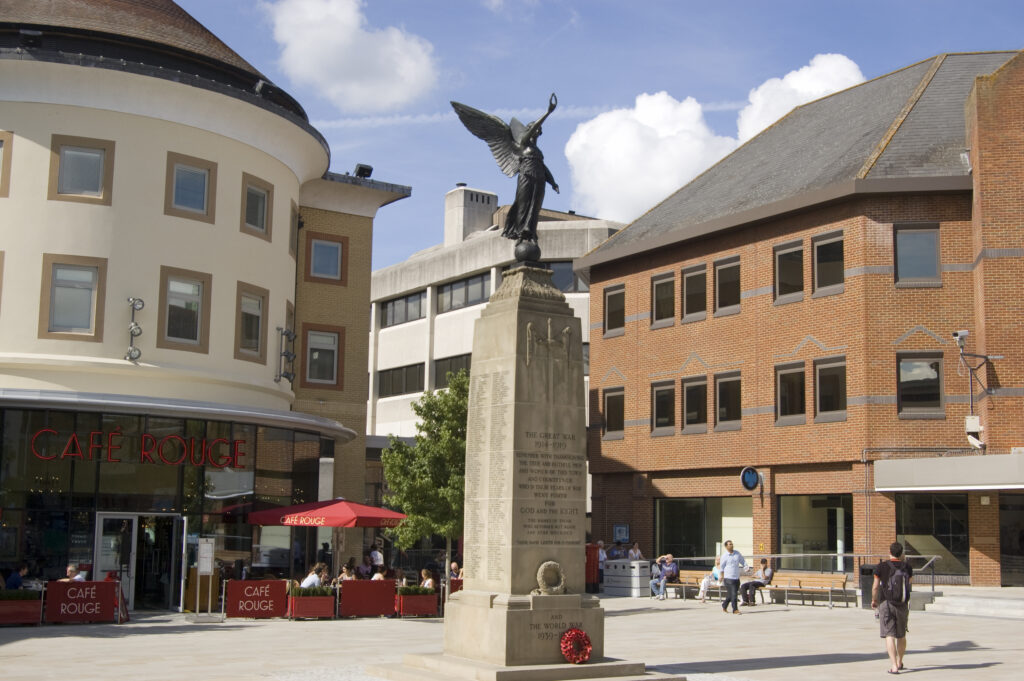
Though often considered a modern commuter hub, Woking has layers of history and culture that reward closer exploration. Its most distinctive feature is the Shah Jahan Mosque, built in 1889 as the first purpose-built mosque in Britain, reflecting the town’s multicultural heritage.
Woking also celebrates literary connections: The War of the Worlds by H. G. Wells, who lived here, is commemorated by a striking Martian tripod sculpture in the town centre. The Lightbox Gallery and Museum showcases art and local history, offering exhibitions that range from classic to contemporary.
The town has invested heavily in green spaces, with Horsell Common—a Site of Special Scientific Interest—providing a vast natural area of heathland, woodland, and ponds, famously featured in Wells’s novel as the landing site of the Martians.
Modern yet historic, urban yet green, Woking represents Surrey’s dynamic side, connecting tradition with innovation.
Epsom
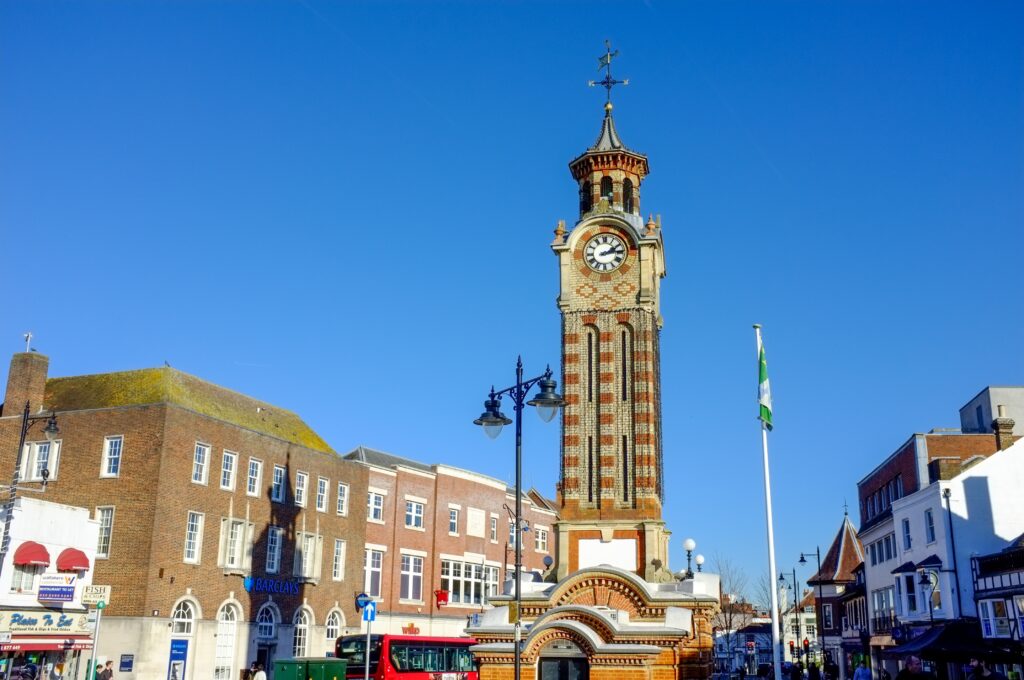
Best known for its world-famous racecourse, Epsom is a town where sport, history, and health intertwine. The Epsom Downs Racecourse has been the site of the Derby since 1780, one of the most prestigious events in the racing calendar, drawing visitors from around the globe. The Downs themselves are also a natural haven, offering panoramic views across London and Surrey.
Epsom’s fame extends beyond racing. In the 17th century, it became renowned as a spa town after the discovery of mineral-rich waters. The resulting Epsom salts, first distilled here, became a household name and spread the town’s reputation across Europe.
The town centre retains Georgian and Victorian architecture, alongside a vibrant mix of shops, cafés, and cultural venues. The nearby Epsom Common and Horton Country Park add to its appeal, offering large open spaces for walking and wildlife.
With its unique blend of sporting prestige, historical curiosity, and natural beauty, Epsom remains one of Surrey’s most distinctive destinations.
Leatherhead
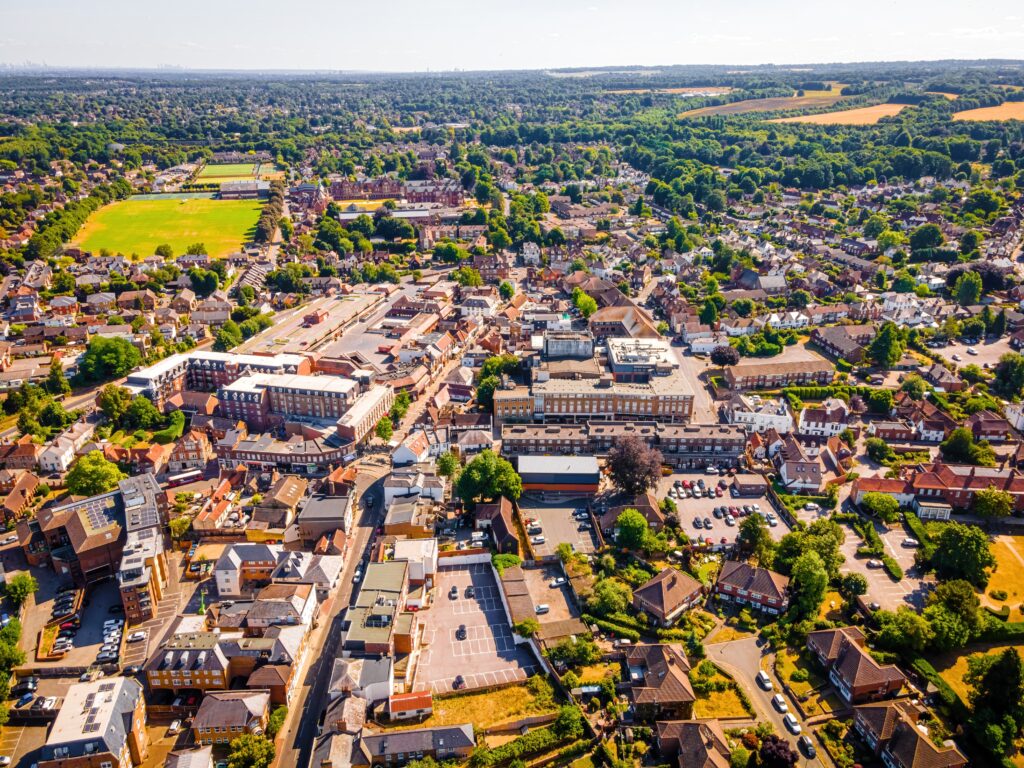
Situated on the banks of the River Mole, Leatherhead is a historic market town that bridges tradition and modernity. Its roots stretch back to Saxon times, and its position at a key river crossing gave it strategic importance through the centuries.
The town centre features a blend of medieval, Georgian, and Victorian buildings, with St Mary and St Nicholas Church at its heart, dating from the 11th century. The Running Horse Inn, one of Surrey’s oldest pubs, is another reminder of Leatherhead’s long history as a stop for travellers.
Leatherhead is also a gateway to the Surrey Hills AONB. From here, walkers can easily access the dramatic landscapes of Box Hill, Headley Heath, and the River Mole Valley, where chalk cliffs, meadows, and woodland combine in striking variety.
Today, Leatherhead thrives as a commuter town with excellent connections, yet it retains its character through markets, theatres, and riverside walks. Its role as both historic settlement and countryside hub makes it a key stop in Surrey’s story.
Godalming

With its timber-framed houses, riverside setting, and hilly backdrop, Godalming is one of Surrey’s most picturesque towns. Prosperity from the wool trade in the Middle Ages and later as a coaching town has left a legacy of fine architecture, including the 17th-century Guildhall, which still dominates the High Street.
Godalming has a proud place in history as the first town in the world to have a public electricity supply, switched on in 1881. Its innovation continues today with a thriving local economy and vibrant cultural life. The town is also linked to Charterhouse School, one of England’s great public schools, whose Gothic Revival buildings form a striking presence on the hillside.
The River Wey runs through the town, providing peaceful walks and connections to the Wey Navigations, while surrounding countryside and woodlands make Godalming a favourite for ramblers. With its blend of heritage, innovation, and natural beauty, Godalming epitomises the appeal of Surrey’s small towns.
Haslemere
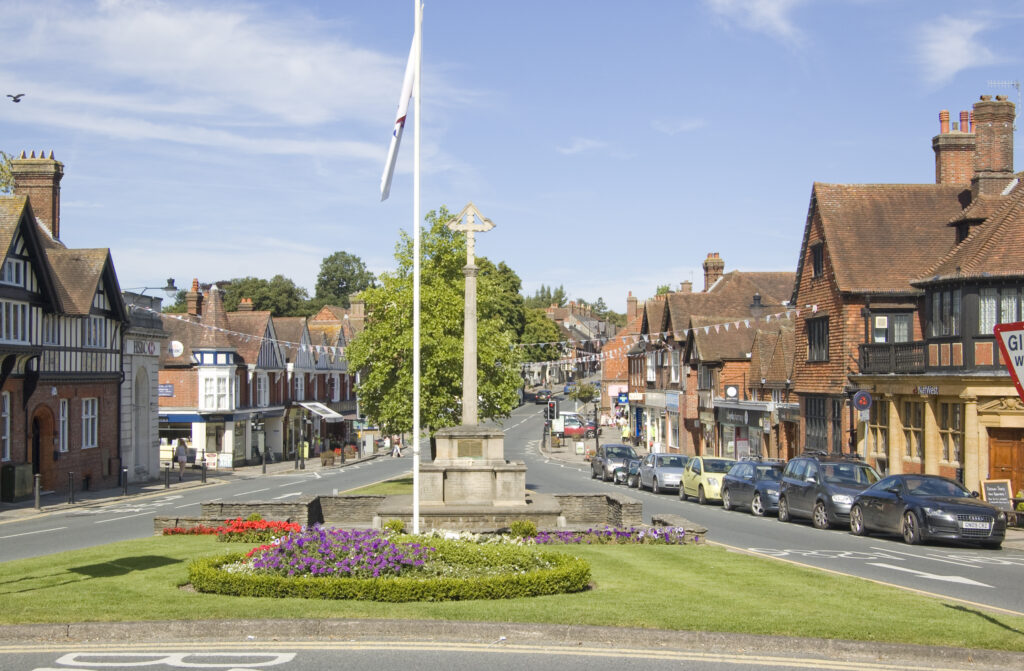
On Surrey’s southern edge, bordering Hampshire and West Sussex, lies Haslemere, a town known for its scenic setting and cultural heritage. Surrounded by the rolling hills of the Surrey Hills AONB, including Blackdown Hill—the county’s highest point—it offers some of the finest walking and views in the region.
Haslemere’s historic core centres on the High Street, lined with Georgian houses, coaching inns, and independent shops. The Haslemere Educational Museum, one of the country’s oldest independent museums, showcases natural history, local archaeology, and ethnography, reflecting the town’s long commitment to learning and culture.
The town is also celebrated for its connections to the Arts and Crafts movement, with nearby homes and gardens designed by Sir Edwin Lutyens and Gertrude Jekyll. This artistic heritage continues in the area’s thriving arts scene, with concerts, festivals, and community events.
Haslemere is more than a charming town—it is a gateway to the South Downs and the wider landscapes of southern England. Its combination of history, artistry, and natural splendour makes it one of Surrey’s jewels.
Cranleigh

Often called England’s largest village, Cranleigh combines the feel of a bustling market town with the intimacy of village life. Its long High Street is lined with independent shops, cafés, and historic buildings, including the parish church of St Nicolas, which dates back to Norman times.
Cranleigh’s prosperity grew in the 19th century with the arrival of the railway, and its character remains shaped by Victorian architecture, including Cranleigh School, a leading independent institution whose elegant buildings contribute to the town’s identity.
The surrounding countryside is a major draw, with the nearby Surrey Hills providing endless opportunities for walking, cycling, and horse riding. The Downs Link trail, following a disused railway line, connects Cranleigh to Guildford and the South Downs, making it a popular route for outdoor enthusiasts.
With its mix of heritage, education, and community spirit, Cranleigh balances tradition with a lively cultural life, cementing its reputation as one of Surrey’s most welcoming settlements.
Weybridge
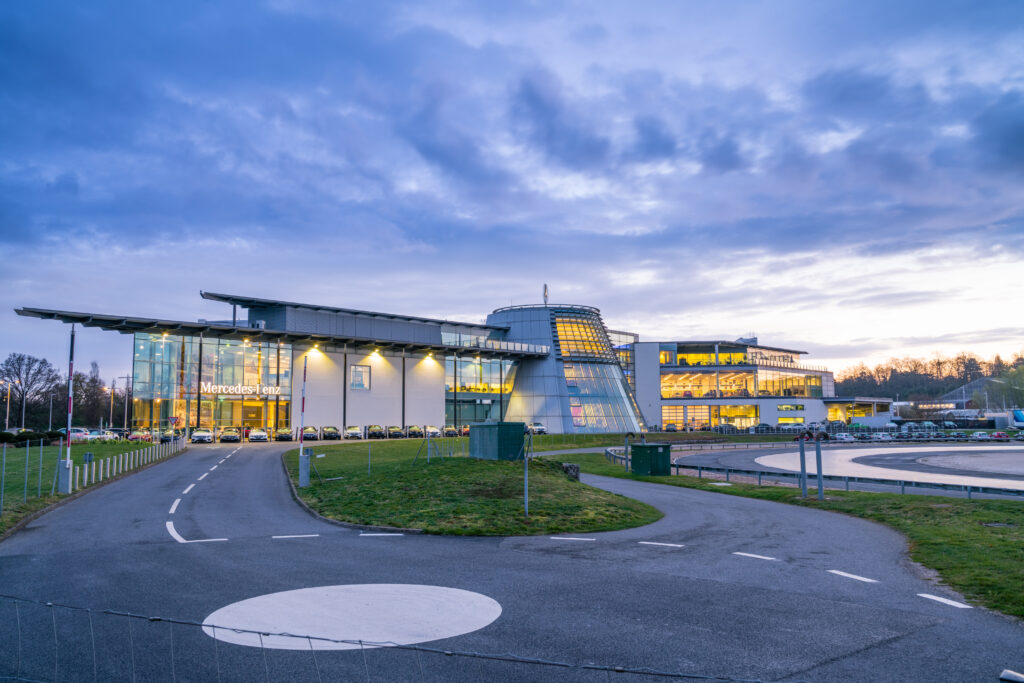
Located on the River Wey near its confluence with the Thames, Weybridge is a town shaped by water, history, and innovation. In earlier centuries, its riverside position made it a popular retreat for London’s elite, and many fine houses still line the area.
Weybridge is perhaps best known as the home of Brooklands, the birthplace of British motorsport and aviation. The world’s first purpose-built racetrack opened here in 1907, and today the Brooklands Museum celebrates this pioneering spirit with vintage cars, aircraft, and even a Concorde on display.
The town’s riverside is another highlight. Walks along the Wey and the Thames reveal peaceful scenery, while attractions such as Oatlands Park and Mercedes-Benz World showcase both heritage and modern engineering.
Weybridge thus reflects Surrey’s role as both innovator and retreat: a town where cutting-edge history meets riverside charm.
Esher
In the leafy north of Surrey, Esher is a town that combines affluence, heritage, and leisure. Its proximity to London has long made it a desirable residence, and today it retains a reputation for elegance.

The town is best known for Sandown Park Racecourse, a premier venue for flat and jump racing that has attracted crowds since the 19th century. Beyond racing, Esher offers green spaces such as Claremont Landscape Garden, a National Trust site designed by great 18th-century landscape architects including Capability Brown and William Kent. This sweeping garden of lakes, lawns, and woodlands captures the golden age of English garden design.
Esher’s High Street is lined with chic restaurants, pubs, and shops, reflecting its modern prosperity, while historic churches and stately homes provide a link to the past.
With its racecourse, landscaped gardens, and contemporary lifestyle, Esher is a prime example of Surrey’s blend of tradition and sophistication.
Walton-on-Thames
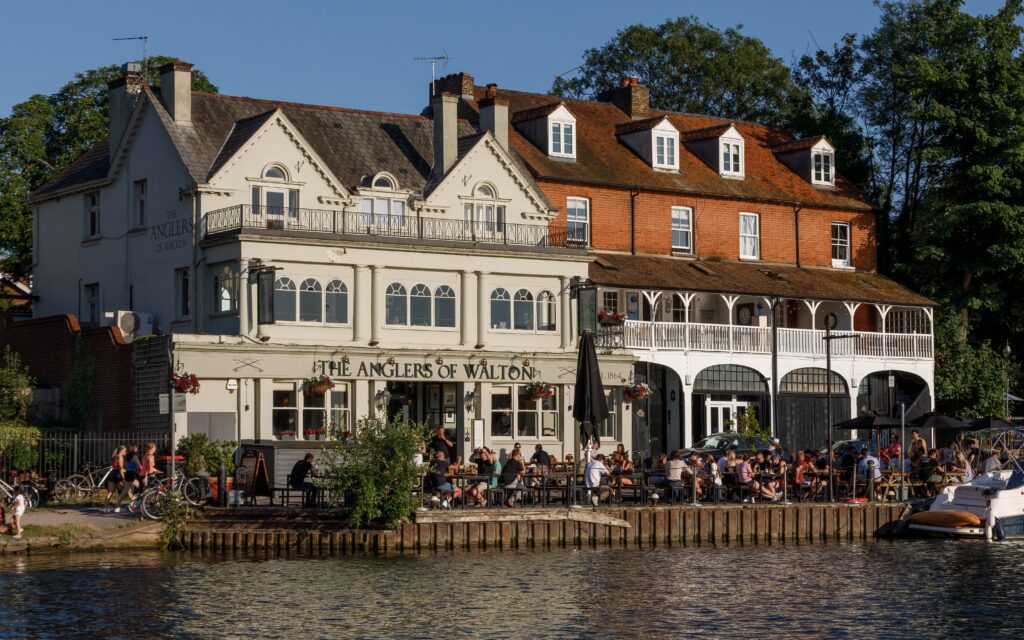
Set on a broad bend of the River Thames, Walton-on-Thames combines riverside charm with a lively town centre. Its riverside walks are among the most scenic in Surrey, with paths stretching towards Hampton Court and Shepperton, lined with pubs, boathouses, and leafy views.
Historically, Walton was a settlement of importance, recorded in the Domesday Book. Its parish church, St Mary’s, contains Saxon and Norman elements, linking the modern town to its deep past. In later centuries, Walton became a desirable riverside retreat, and its history is still reflected in handsome Georgian and Victorian houses.
Today, Walton thrives as a commuter town with excellent amenities, but it retains a strong community identity through markets, theatre, and cultural events. The nearby Sunbury Lock and Walton Bridge highlight its riverside heritage, while leisure facilities and shopping centres connect it to modern life.
Walton-on-Thames, with its river setting and historic continuity, is a place where Surrey’s rural and urban qualities meet in harmony.
Chertsey
One of Surrey’s oldest towns, Chertsey has roots reaching back to the 7th century with the founding of Chertsey Abbey, one of England’s earliest monasteries. Although the abbey was largely destroyed in the Dissolution, fragments remain, and its legacy still defines the town’s identity.
The parish church of St Peter’s preserves connections to this religious past, while the town centre reflects centuries of growth with Georgian facades and historic coaching inns. Chertsey was also closely tied to the Thames, serving as a crossing and trading point, and its riverside continues to be central to its charm.
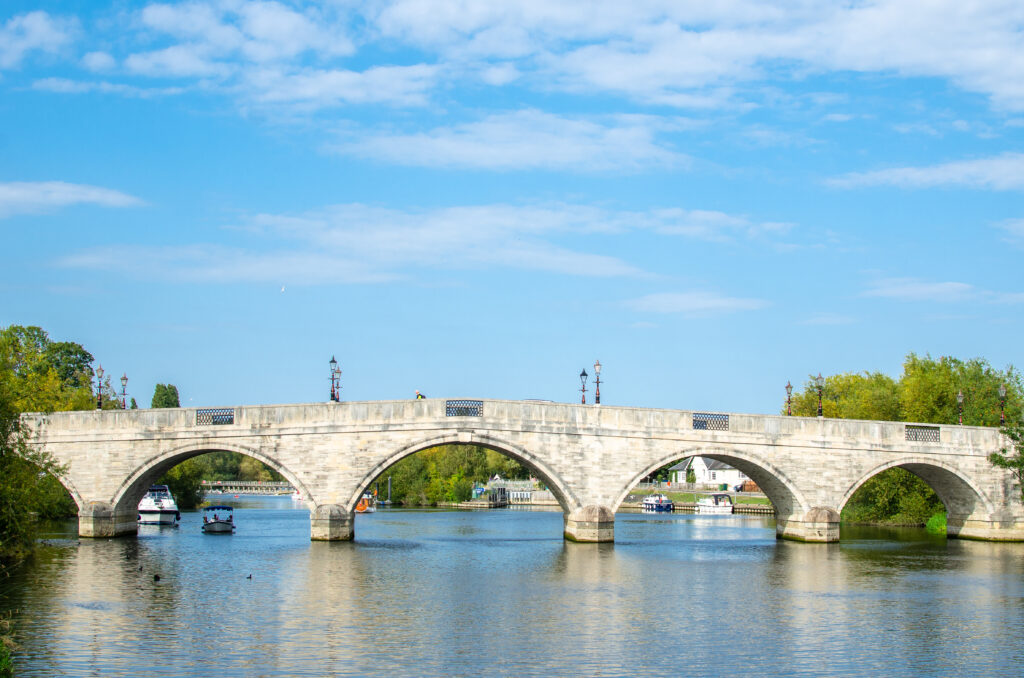
Nearby attractions include Chertsey Bridge, an elegant 18th-century stone crossing, and Thorpe Park, one of Britain’s leading theme parks, which brings a modern edge to the area. Together, they show Chertsey’s ability to bridge heritage and contemporary leisure.
As a town where early medieval history meets riverside scenery and modern attractions, Chertsey encapsulates the diversity of Surrey’s story.
Egham
On Surrey’s northern edge, Egham is a town of immense historical significance. Just outside the town lies Runnymede, the meadow where King John sealed the Magna Carta in 1215. This landmark moment in constitutional history is commemorated by memorials from the American Bar Association, the Magna Carta Memorial, and the nearby Air Forces Memorial at Cooper’s Hill, which honours airmen of the Second World War.
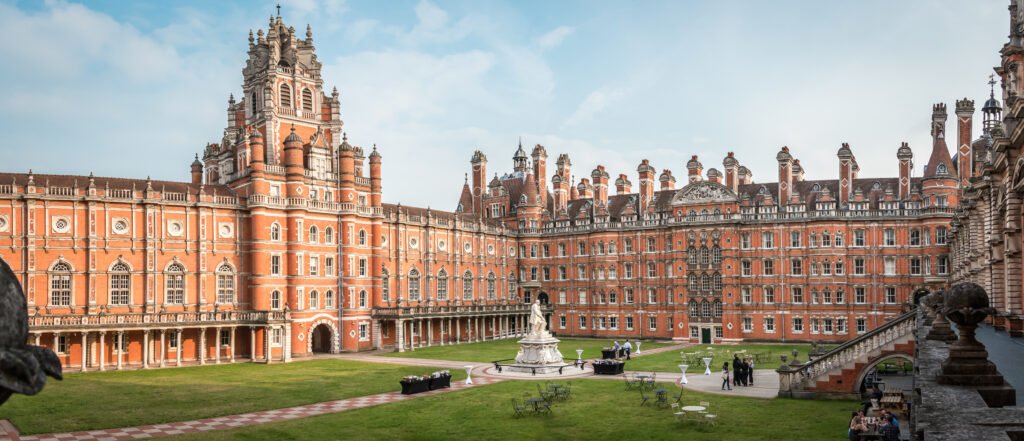
Egham itself is a thriving university town, with Royal Holloway, University of London—a striking Victorian red-brick building inspired by the French châteaux—providing both architectural splendour and cultural vibrancy. The campus is one of the most beautiful in Britain, with its quadrangles, towers, and chapel nestled among landscaped grounds.
Modern Egham balances student life, history, and riverside walks along the Thames. Its proximity to London Heathrow also places it at a crossroads of local and global significance.
With Magna Carta at its heart and a university that embodies Victorian ambition, Egham is a town that links Surrey to some of the great currents of world history.
Dunsfold

Though smaller than many Surrey towns, Dunsfold is internationally recognised thanks to Dunsfold Aerodrome. Built during the Second World War, the airfield later became home to aviation innovations and, more recently, to the BBC’s Top Gear test track. The aerodrome’s story captures Surrey’s role in Britain’s wartime and post-war aviation history.
The village of Dunsfold itself, however, retains a timeless quality. The parish church of St Mary and All Saints, with origins in the 12th century, anchors a community surrounded by farmland, woods, and quiet lanes. The village green, cottages, and local pub preserve a sense of traditional Surrey life.
This contrast—between global fame through aviation and local continuity through its rural setting—makes Dunsfold a fascinating part of Surrey’s patchwork. It is both modest village and place of international recognition.
Shere
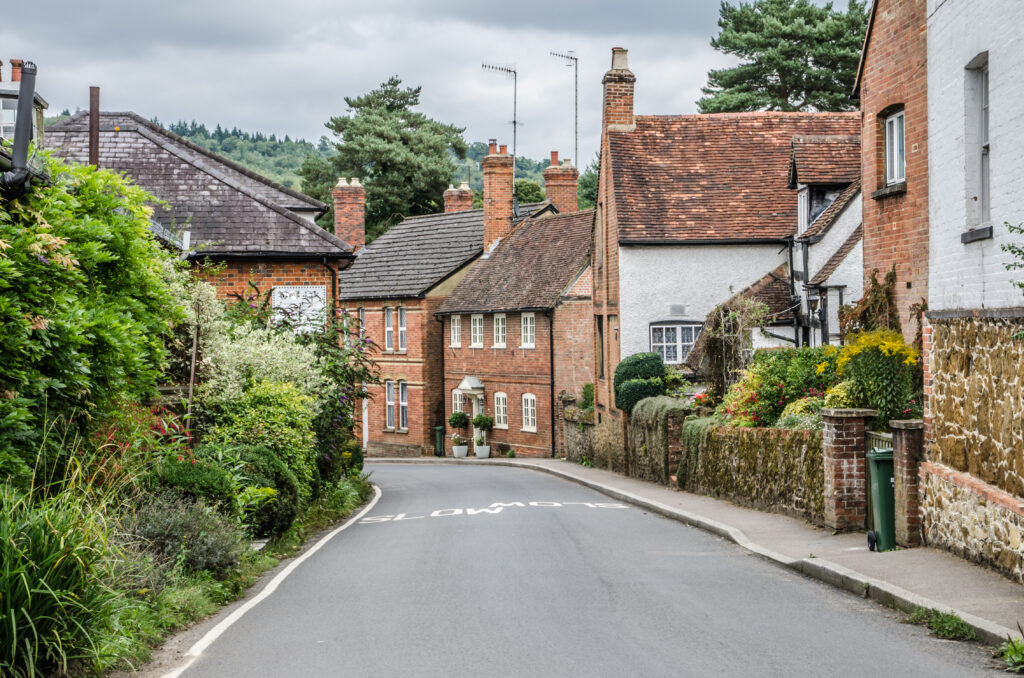
Often described as Surrey’s prettiest village, Shere is nestled in the Surrey Hills and epitomises English rural charm. With timber-framed cottages, narrow lanes, and a babbling stream running through the centre, it has long been a favourite for filmmakers, featuring in movies such as The Holiday and Bridget Jones: The Edge of Reason.
At its heart stands the Church of St James, a Norman foundation with distinctive architecture and a tranquil churchyard. Traditional pubs such as The White Horse and The William Bray add to the village’s timeless appeal, while independent shops and tearooms welcome visitors.
Surrounded by wooded hills and meadows, Shere is also a gateway to some of the Surrey Hills’ best walking trails, including routes up to Newlands Corner and through the Tillingbourne Valley. Its combination of beauty, history, and atmosphere make it one of the most beloved destinations in the county.
Abinger
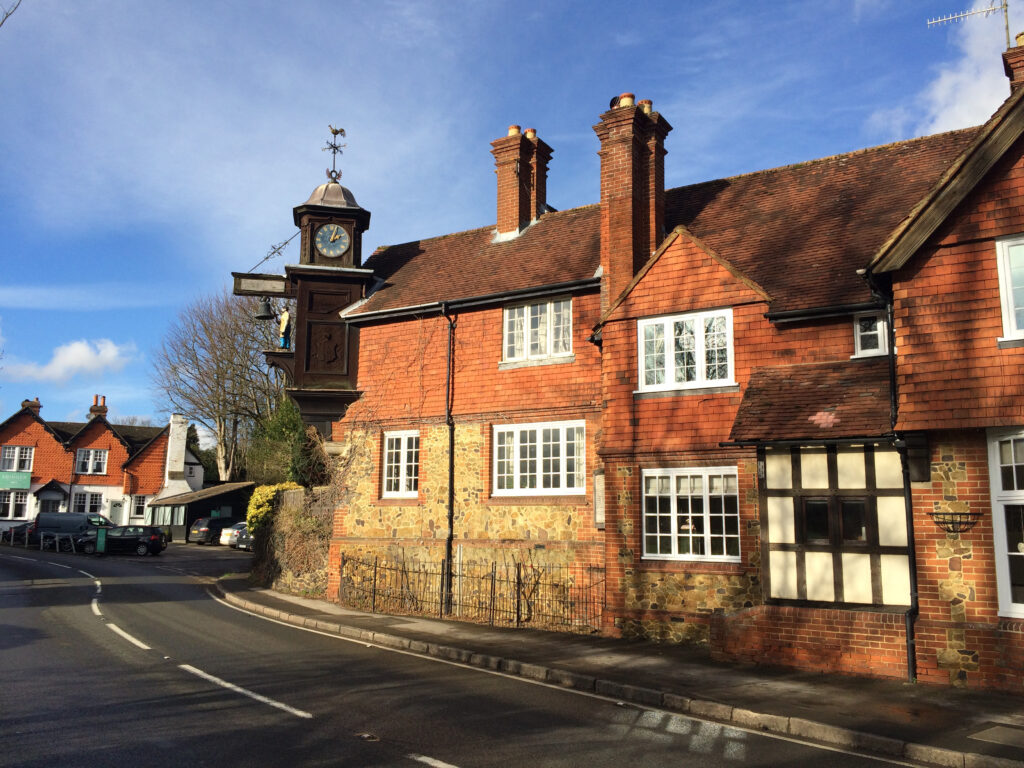
Divided into the charming settlements of Abinger Hammer and Abinger Common, this part of Surrey combines scenic countryside with rich history. Abinger Hammer is best known for its iconic clock over the village smithy, which features a figure striking the hour—a much-loved local landmark. The village is set along the Tillingbourne River, where traditional cottages line the banks.
Nearby Abinger Common offers expansive heathland and woodland walks, forming part of the Surrey Hills AONB. The area has deep archaeological significance too: excavations revealed one of the earliest Romano-British villas in Surrey, pointing to its ancient roots.
Abinger is a place where heritage and landscape come together, offering the tranquillity of rural life alongside the fascination of a settlement shaped by centuries of history.
Godstone
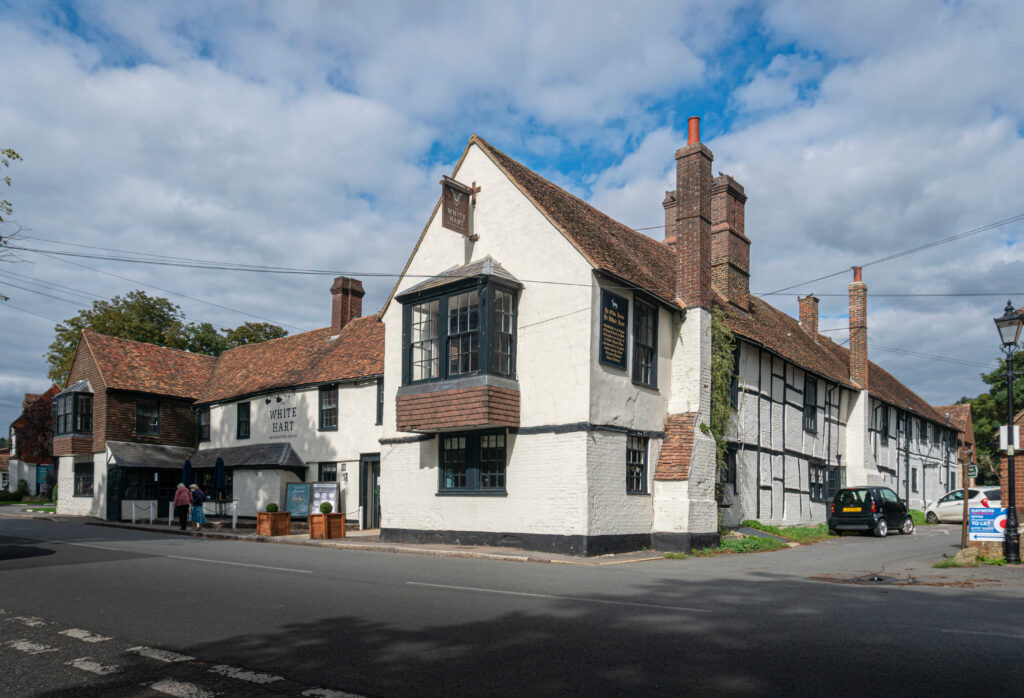
Lying on the eastern side of the county, Godstone is a village rich in history and community spirit. Its large village green is framed by historic houses, inns, and the parish church of St Nicholas, which dates back to the 13th century.
In the past, Godstone prospered through quarrying and agriculture, while today it is known for its beauty and accessibility. The surrounding countryside offers excellent walking, with connections to the Greensand Way trail and nearby hills.
The village has also embraced family-friendly attractions, with Godstone Farm providing a popular destination that blends rural life with education and play. Traditional pubs and tearooms ensure a warm welcome, preserving Godstone’s role as a stopping place on the London to Brighton road.
Balancing history, rural charm, and modern appeal, Godstone exemplifies Surrey’s ability to preserve tradition while embracing change.
Effingham
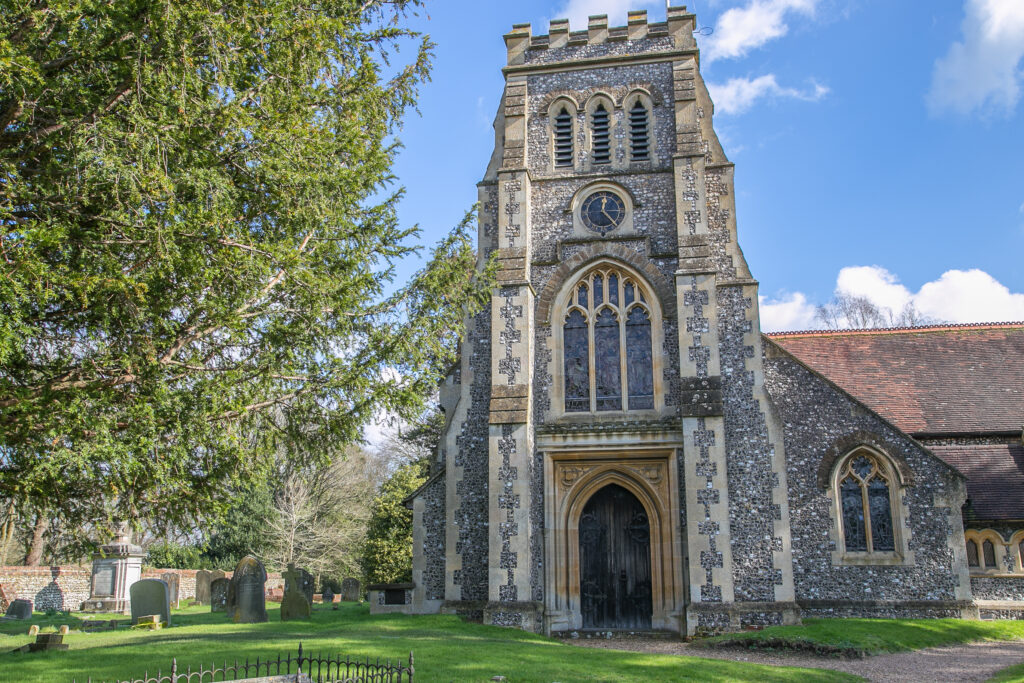
Nestled on the edge of the Surrey Hills, Effingham is a village that combines history, countryside, and a sense of continuity. Its roots stretch back to the Domesday Book, and traces of its long past remain in landmarks such as the Church of St Lawrence, a medieval building at the heart of the village.
Effingham is surrounded by rolling countryside, particularly the wooded slopes and chalk grasslands of Effingham Forest and Ranmore Common. These landscapes are part of the Surrey Hills AONB and provide walkers with rich opportunities to explore nature and heritage side by side.
The village is also known for Howard of Effingham School, named after the 16th-century nobleman who commanded English forces alongside Sir Francis Drake at the defeat of the Spanish Armada. This historical tie gives Effingham a unique place in national history, linking a quiet Surrey village to one of England’s most celebrated victories.
Effingham today is both a commuter base and a strong local community, retaining its identity through traditions, open spaces, and heritage.
Tatsfield
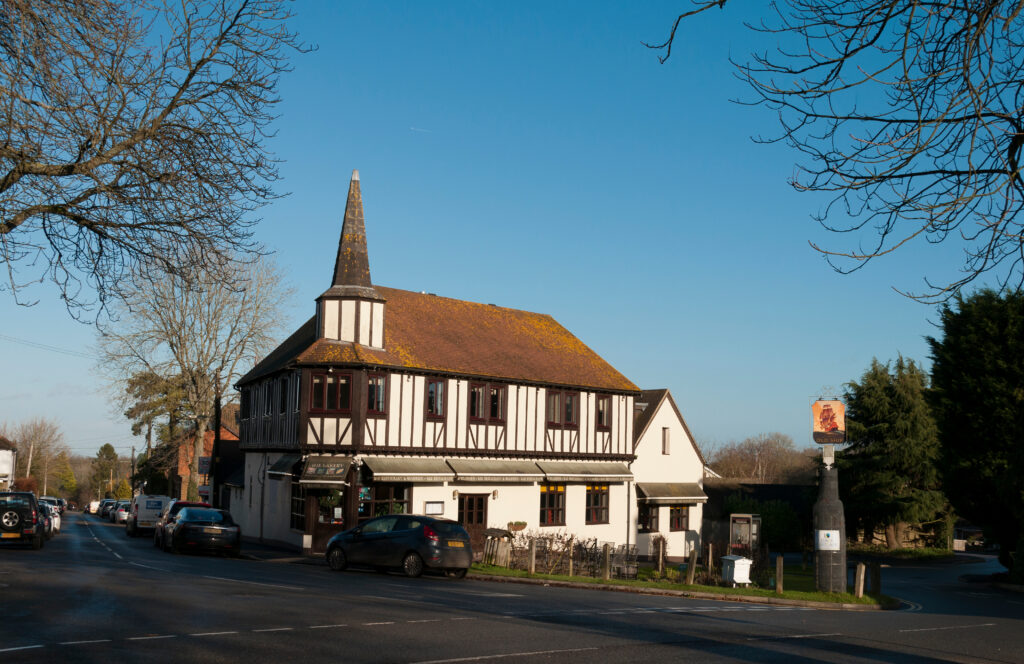
Right on Surrey’s border with Kent, Tatsfield is a hilltop village with a strong sense of independence and charm. The village green serves as its heart, framed by a church, a pub, and traditional houses. Its elevated position on the North Downs makes it one of the most scenic villages in the county.
Tatsfield has long been known for its close-knit community, with events on the green and local traditions binding residents together. Surrounding the village are open fields, woodlands, and trails, including connections to the North Downs Way, one of England’s great walking routes.
Despite its rural feel, Tatsfield is within easy reach of London, creating a balance between countryside seclusion and metropolitan access. Its beauty, community spirit, and landscape make it a memorable stop in Surrey’s story.
Windlesham

Tucked in northwest Surrey, Windlesham is a village that feels both secluded and welcoming. Its name, meaning “homestead in the wind,” hints at its historic rural roots. The village green, pubs, and churches form the heart of community life, while the surrounding countryside offers quiet lanes, woodlands, and heathland.
Windlesham is particularly proud of its traditions. The Windlesham Pram Race, held each Boxing Day, is a quirky and beloved local event where teams race decorated prams through the village, raising money for charity. This playful tradition captures the spirit of the community, blending humour, competition, and generosity.
Although modern development has brought new residents, Windlesham has preserved its village identity. With its friendly character, annual traditions, and rural charm, it represents Surrey’s enduring ability to balance old and new.

